Maximizing Kitchen Efficiency with Versatile Plastic Dividers
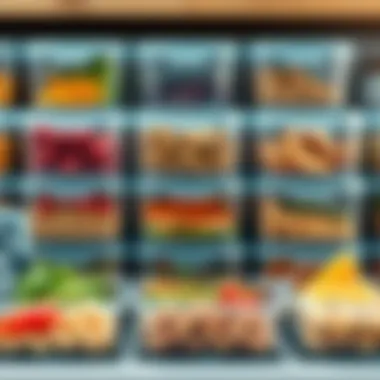
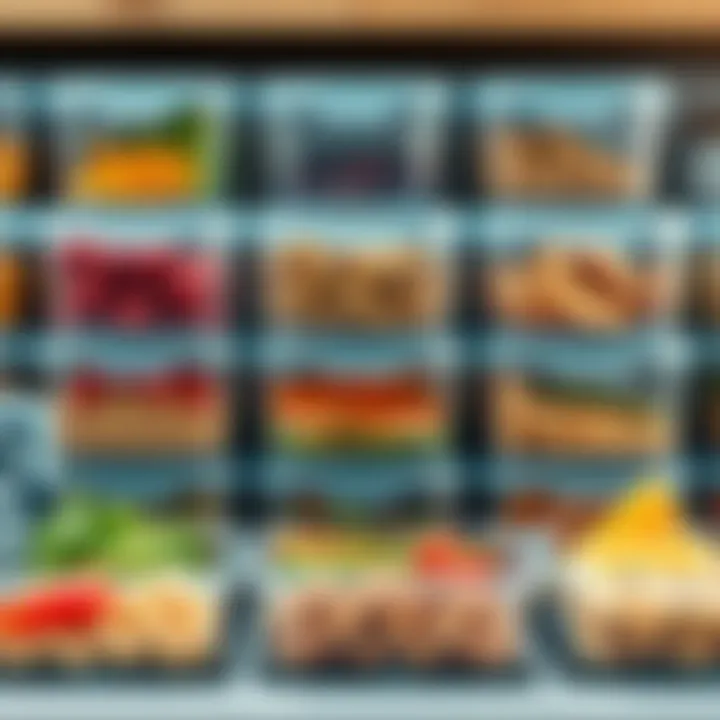
Intro
In today’s fast-paced world, managing our food storage has gone from a mere chore to a vital aspect of our daily lives. The rise of meal prepping and an emphasis on healthy eating have spotlighted the importance of utilizing plastic food containers with dividers. These containers not only keep various food items organized but also cater to those looking to maintain portion control and optimize freshness. This exploration dives into the diverse applications and advantages these plastic containers offer, making them a staple in kitchens across the globe.
Versatility of Plastic Food Containers
These innovative containers come in a variety of shapes and sizes. The dividers within them play a significant role in their versatility, allowing users to separate different ingredients, be it sauces, snacks, or full-fledged meals. Whether you’re packing lunch for work, storing leftovers, or trying to keep various snacks neat in the pantry, these containers shine.
Food Storage Efficiency
Undoubtedly, one of the most compelling reasons for their popularity lies in food storage efficiency. With designated sections, you can keep flavors from mingling—a vital factor when packing fruits next to savory items. Here’s a brief look at their key benefits:
- Portion Control: Perfect for those watching their diet. You can easily count servings when everything is neatly divided.
- Longer Freshness: Separated ingredients tend to last longer since they aren't exposed to each other’s moisture and odors.
- Convenient Meal Prep: Easily prepare multiple meals at once, ensuring you’re ready for the week ahead.
Practical Applications
The practical applications of these containers extend beyond just meal prep at home. They are equally useful in a variety of settings, such as:
- First Aid Kits: Many medical supplies can be organized in these containers, ensuring that bandages don’t stick to ointments or other items.
- Art Supplies: Keep colored pencils, markers, and brushes tidy for easy access.
- Lunch Boxes for Kids: Parents can include a diverse range of snacks without the risk of mixing flavors, making lunchtime more fun for children.
Health and Sustainability Considerations
In an era focused on sustainability, the materials in making these storage containers can be a topic worth discussing. Many of them utilize BPA-free plastics, which are essential for ensuring safety in food storage. Additionally, opting for containers that can be reused rather than single-use plastic bags contributes positively to the environment.
Choosing the Right Container
When selecting plastic food containers with dividers, consider the following criteria:
- Material Quality: Look for sturdy, BPA-free options that won’t warp easily.
- Sealing Mechanisms: Great sealing helps in maintaining freshness and avoiding spills.
- Size and Design: Choose containers that fit your kitchen space and personal aesthetic without compromising on functionality.
Maintenance and Care
Taking care of these containers can significantly extend their lifespan and maintain their performance. The best practices include:
- Regular Cleaning: Avoid harsh chemicals. Warm soapy water works wonders.
- Avoid Microwaving on High Heat: Some plastics can degrade under high temperatures, leading to unwanted chemicals leaching into food.
- Storing Properly: Make sure they are completely dry before stacking or storing to prevent mildew.
Culmination
Plastic food containers with dividers are much more than simple storage solutions. They represent a blend of practicality and design, enhancing day-to-day life for a wide array of users—from home cooks to professionals. By understanding their benefits and incorporating them intelligently into your kitchen, you can foster a more organized, sustainable, and health-conscious lifestyle.
"The right tools make all the difference in a well-run kitchen, and the value of organization cannot be overstated."
For more information and insights into sustainable kitchen practices, check out resources like EPA.gov and FoodSafety.gov where you can find valuable tips and guidelines to enhance your food storage practices.
An Prelude to Plastic Food Containers with Dividers
Plastic food containers with dividers have increasingly become a staple in kitchens around the world, serving a multitude of purposes that extend beyond mere containment. The advent of these containers signals a shift in how individuals not only store food but how they approach meal preparation, artistry in presentation, and the understanding of space utilization within the kitchen. This article sheds light on their significant role, demonstrating how these containers answer modern needs, catering to both form and function.
In the age of fast-paced lifestyles, organization is key. Plastic containers with dividers simplify meal prep and enhance storage efficiency. Whether you’re a bustling parent juggling meals for the kids or a single professional trying to navigate lunchtime options at work, these containers offer a myriad of advantages. With a range of compartments, meal portions can be neatly separated, leading to better structure in your culinary practices. People tend to gravitate towards solutions that streamline their routines, and these dividers certainly fit the bill.
Defining Plastic Food Containers
Plastic food containers are vessels designed for food storage, typically crafted from a variety of plastics known for being lightweight, affordable, and versatile. They come in multiple sizes, shapes, and designs which can minimize unwanted air exposure, thereby prolonging the freshness of the stored food. This innovation shifts from traditional glass or metallic containers, which can be heavier and more cumbersome.
Furthermore, the ease of washing plastic containers makes them family-friendly. They can often endure the rigors of everyday usage while maintaining their integrity under frequent washing and use. The advent of BPA-free options enhances their safety profile, ensuring that harmful chemicals do not leach into food, which is a huge plus for health-conscious consumers.
Understanding Dividers within Containers
Dividers within these plastic food containers serve a crucial role in maintaining the quality and presentation of food. They allow for multiple types of foods to be stored in a single container without the risk of cross-contamination of flavors or textures. Imagine a lunchbox that keeps your crisp salad away from your succulent grilled chicken, or a snack container that neatly separates nuts and dried fruits — this is the essence of utility offered by dividers.
These compartments can be tailored to fit various dietary needs, aiding portion control. By visually separating different food types, they encourage healthier eating habits, as individuals can quickly assess their meal balance, ensuring a more nutritional variety.
"The use of dividers not only enhances the functionality of storage, but it also adds an element of creativity to meal presentation. People often eat with their eyes, and a well-organized container can be just as appetizing as the meal itself."
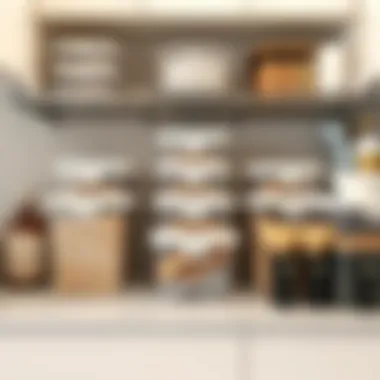
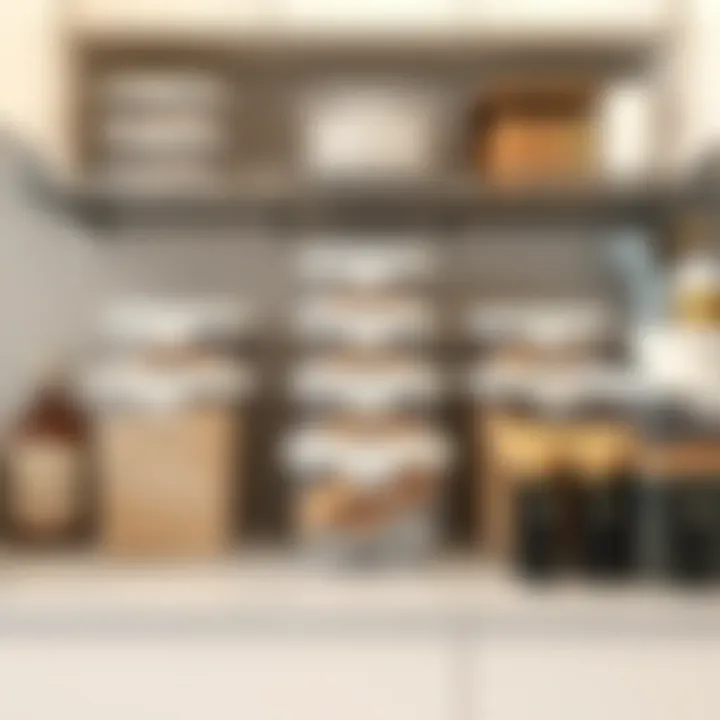
In summary, the introduction of plastic food containers with dividers represents an evolution in food storage solutions. They encompass efficiency and creativity while aligning with contemporary health standards, making them indispensable in any kitchen or for dining on the go.
Functional Benefits of Dividers
The versatility of plastic food containers with dividers cannot be overstated. As pros in meal prep and food storage know, the very inclusion of dividers brings functionality to a whole new level. These innovative designs cater directly to our needs, be they from a culinary angle or a lifestyle one. From keeping your meals neat to supporting your healthy eating habits, the benefits of dividers stretch beyond mere convenience. Let's break this down further to appreciate these functional advantages fully.
Enhanced Organization
Imagine opening your refrigerator and seeing not just a jumble of food but a beautifully organized setup. With dividers in plastic containers, enhanced organization is a reality. These dividers allow for distinct compartments, which means you can store different food types without them mixing together. Think about it—you can pop some fresh strawberries in one section, sliced cucumbers in another, and even a small serving of hummus, all without worry.
"A place for everything and everything in its place."
This age-old saying rings true for modern kitchens, where decluttering is essential. When you separate food items within their respective compartments, it reduces the chance of spoilage. Plus, it adds a little zen to your cooking routine. Trying to whip up a meal becomes less chaotic when every ingredient is right where you expect it. You'll likely find that meal prep turns into a more enjoyable experience.
Additionally, from a practical standpoint, dividers can save you time. Picture yourself grabbing a pre-prepared container from the fridge, knowing exactly where each ingredient is located. No more digging around or guessing, and I’d say that’s a win in anyone’s book.
Maintaining Food Integrity
When talking about food preservation, the importance of maintaining food integrity cannot be overstated. Utilizing dividers in plastic containers acts like a shield, protecting your food from cross-contamination and ensuring their respective flavors remain intact. Take for example a container featuring sections for savory and sweet snacks; by keeping them separate, you ensure that your dark chocolate-covered almonds do not wind up tasting like cheddar cheese crisps.
In a world increasingly focused on health-conscious eating, keeping flavors intact is paramount. Dividers not only keep tastes distinct but also guard against moisture and air that might affect food quality over time. When compartments are utilized effectively, you ensure that each ingredient maintains its intended taste and texture longer than if they were all tossed together.
Moreover, for those watching their nutritional intake, dividers also help in accurately tracking portion sizes. It’s much easier to know how much of each food group you have when they are contained separately. Ultimately, by ensuring that flavors and textures are preserved, dividers help amplify the overall eating experience, making every bite as delightful as possible.
Practical Applications in Everyday Life
Plastic food containers with dividers stand as unsung heroes in our kitchens, serving multiple roles that go beyond mere storage. They cater to the modern lifestyle where convenience, organization, and health are paramount. Their versatility opens a cornucopia of opportunities, making them integral to meal preparation, lunch packing, and even managing portion control for health enthusiasts. Each application highlights their everyday significance, showcasing how they adapt to the varied needs of homeowners, designers, and culinary aficionados alike.
Meal Prep Efficiency
When it comes to meal prep, efficiency is the name of the game. Dividers in containers allow you to separate different food items without the hassle of mixing flavors—perfect for those who like to meal prep for the week ahead. You can neatly compartmentalize grilled chicken, rice, and vegetables all in one container, making it easy to grab a balanced meal on the go.
- Saves Time: Streamlining meal prep means less time spent in the kitchen. You can batch cook foods and store them all in one go. Just pop them in the fridge and you’re ready to roll.
- Promotes Freshness: Each section keeps foods fresh and untainted by odors or flavors from other ingredients. This can be especially crucial for items like sauces and dressings, which can easily impact the taste of the entire dish if combined prematurely.
- Limitless Combinations: From pasta salads to grain bowls, the dividers allow you to mix and match your ingredients without worrying about them colliding. Choose your base, protein, and veggies without compromising on texture or taste.
Incorporating these containers into your weekly routine can transform meal prep from a daunting task into a seamless process, paving the way for healthier eating habits.
Packaged Lunch Solutions
Preparing a lunch that is both nutritious and appetizing can often be a challenge. Enter the plastic food container with dividers—your ally in crafting the perfect work or school lunch.
- Balanced Meals on the Go: Rather than tossing a hodgepodge of snacks in your bag, dividers ensure your options are not only organized but also health-conscious.
- Variety and Control: Imagine a lunch box where you could include a slice of quiche, a small salad, and some fruit, all without worrying that one item will ruin the others. Each element stays separate, making your lunch visually appealing and effortlessly delightful.
- Kid-Friendly Options: For parents, these containers are a game changer. Make lunchtime exciting by involving kids in choosing their favorite foods each week—diced veggies, small rolls, and hummus—kept neatly in separate compartments.
Moreover, these containers alleviate the need for plastic wrap or bags, becoming a sustainable solution for those looking to reduce their environmental footprint.
Portion Control for Health
In a society increasingly aware of dietary choices, using containers with dividers can make a notable difference in managing portion sizes. This is particularly relevant for those on specific diets or individuals wanting to maintain a healthy lifestyle.
- Mindful Eating: Dividers create visual cues that aid in serving appropriate portions of different food groups. This method can be particularly useful in preventing overeating, as you are visually reminded of how much you're consuming.
- Nutritional Balance: These containers allow for easy separation of macronutrients. For example, one section can hold your healthy carbs, while another can be designated for proteins and veggies, promoting a balanced plate.
- Tracking Progress: If you’re working out and trying to get fit, having designated areas for portions not only aids in planning meals but also helps in tracking your intake throughout the day.
Design Considerations
When it comes to plastic food containers with dividers, the design choices you make are as vital as the food they hold. Every kitchen's functionality can greatly benefit from thoughtful selection of these containers. Understanding design considerations means you prioritize not just utility, but also aesthetics and sustainability. Let’s venture into various aspects that can heavily influence your purchasing decisions.
Choosing the Right Size
Selecting the right size might seem trivial at first, but consider the all-too-common scenario of the leftovers taking two trips to fit in the fridge. A container that's too small simply won't cut it. Meanwhile, if it's too big, it might lead to waste, both of space and food.
When choosing a size for your container, think about your typical meal prep. For instance, a family of four doesn’t need the same size containers as a single person. Visualizing regular portions can guide you. Here’s a handy tip: go for containers that come in a variety of sizes. This way, you can easily match your needs with specific meals, ensuring nothing goes to waste.
Material Choices and Sustainability
Types of Plastics Used
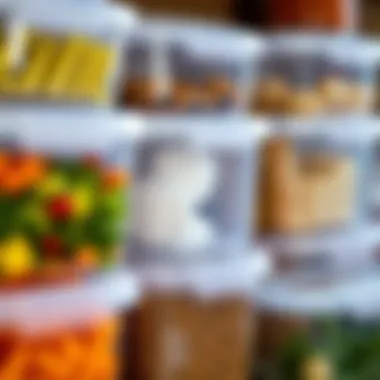
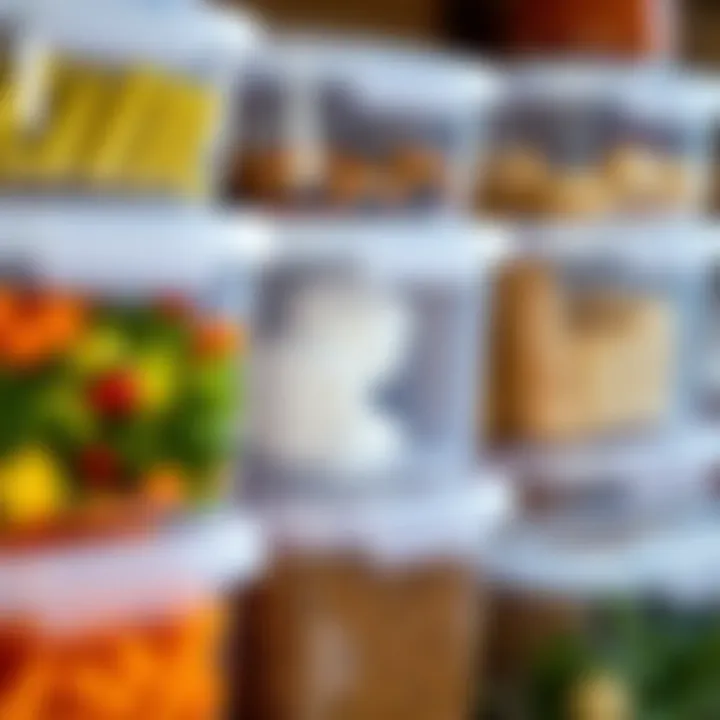
The type of plastic used in food containers is a significant element of the design considerations. Common varieties like polypropylene (PP) and polyethylene terephthalate (PET) are quite popular. Polypropylene is praised for its robustness and resistance to heat, allowing you to pop it in the microwave without worries. On the flip side, low-density polyethylene (LDPE) is flexible, making it easier to seal and great for items like sandwiches. However, some plastics may not be suitable for heavy, juicy foods due to their permeability.
One key characteristic of these materials is their recyclability. Many facilities accept PP, but not all types can guarantee proper recycling pathways. Thus, understanding how to dispose of or recycle your container effectively is part of responsible ownership.
“Informed choices lead to healthier, sustainable habits that benefit both home and planet.”
Biodegradable Alternatives
As the world gets greener, biodegradable alternatives have risen in popularity. These are made from plant-based materials such as cornstarch, which means they break down more easily than traditional plastics. This is a win for eco-conscious consumers looking to decrease their plastic footprint.
However, while biodegradable containers can be a fantastic option for single-use scenarios, they typically lack the durability of conventional plastic. Depending on the food and environment, you may need to be cautious about storage times. In essence, they provide an excellent balance between practicality and sustainability.
Aesthetic Appeal in Kitchen Decor
Beyond utility, the visual aspect of plastic food containers shouldn't be underestimated. A well-organized kitchen not only enhances productivity but also creates a pleasant atmosphere. Containers are now available in an array of colors, shapes, and designs. Imagine vibrant dividers that not only keep your food neatly separated but also complement your kitchen's decor.
For those who care about aesthetics, it’s important to choose containers that harmonize with the overall design of your kitchen. Transparency can showcase the food while bold colors offer a playful twist. Utilizing stylish lids combined with unique dividers enhances both functionality and visual appeal, making mundane food storage an organized masterpiece.
Regrettably, keeping these containers clean and tidy can be a challenge without a thoughtful design. Look for features such as easy-to-clip outers or stackable structures to maximize space while looking good.
Maintenance and Care
When it comes to plastic food containers with dividers, maintenance and care are pivotal for both longevity and functionality. These containers are often the unsung heroes of our kitchens—keeping daily meals organized, reducing spoilage, and enabling portion control. Regular upkeep not only extends the life of these containers but also ensures that food safety is prioritized. Here’s a closer look at some crucial aspects related to their maintenance and care.
Cleaning Tips for Longevity
One of the primary steps in maintaining your plastic containers is understanding the best cleaning practices. Here are top tips to keep your containers spick and span:
- Wash by Hand: While many plastic containers are labeled as dishwasher safe, handwashing is often gentler. A soft sponge and mild detergent can remove food particles without scratching the surfaces.
- Avoid Harsh Chemicals: Strong detergents or abrasive scrubbers can degrade the plastic over time. Stick with gentle soap that will effectively clean without causing damage.
- Use Baking Soda: For stubborn stains or odors, sprinkle some baking soda inside the container, add a small amount of warm water, and let it sit. This natural cleaner is effective and safe for food storage.
- Dry Thoroughly: After washing, make sure to dry your containers properly. Any moisture left can lead to odors or mold growth.
- Store with Care: When stacking containers, it's wise to place tissue paper or a soft cloth between them. This helps avoid scratches and preserves the integrity of the dividers.
Implementing these tips can save you a headache down the line and help your containers serve you well for years.
Avoiding Damage and Deformation
To ensure that plastic food containers retain their shape and functionality, it’s essential to be mindful of usage and storage practices. Here are some suggestions:
- Temperature Awareness: Avoid exposing your containers to extreme heat or cold, as rapid temperature changes can warp them. It’s prudent to let hot food cool down before sealing it in a container.
- Safe Freezing Practices: If you plan to freeze meals in these containers, be cautious not to overfill. Freezing expands food, which could lead to cracks or splits. Leave enough space to allow for expansion.
- Mind the Microwave: Not all plastics are microwave safe. Check for indications on the bottom of your containers, and when microwaving, use it only at moderate power and for short time intervals to prevent deformation.
- Regular Inspections: Make it a habit to examine your containers periodically for any signs of wear, such as cracks or a clouded appearance. Addressing these issues early can prevent food safety concerns.
By paying attention to how you handle and care for your plastic food containers, you can continue to enjoy their versatility without compromising their structure and your food safety.
Keeping your meal prep tools in prime condition is an investment into future meals and overall kitchen efficiency.
Overall, engaging in consistent maintenance and understanding the proper care for your plastic food containers will ensure they remain effective and useful in your kitchen for a long time.
Emphasizing Health and Hygiene
In today’s world, where food safety is more critical than ever, understanding the importance of health and hygiene in food storage practices cannot be emphasized enough. Plastic food containers with dividers play a pivotal role in ensuring that your meals are not only organized but also safe for consumption. These containers simplify meal prep while also being instrumental in safeguarding food against contamination.
Safe Food Storage Practices
Keeping food fresh and safe involves more than just popping leftovers into any container; it requires thought and understanding of proper food storage practices. Plastic food containers with dividers make this task much easier.
First, it’s essential to maintain appropriate temperature controls. Storing food in a divided container allows for quick access, reducing the time food is left out at room temperature. For instance, if you are meal prepping a week’s worth of lunches, placing proteins in one compartment and vegetables in another can encourage you to grab what you need quickly, thus lowering the chance of food sitting out too long.
Also, consider the type of food that goes into these dividers. Separating raw meats from prepared foods is crucial in avoiding cross-contamination. With divided containers, it’s effortless to organize your pantry staples. A simple reminder such as, "divide to thrive!" illustrates how this method prevents overlap and keeps potential contaminants at bay.
Key Points for Safe Storage:
- Always keep perishable foods refrigerated
- Use separate compartments for different food types
- Label containers with dates for easy tracking
- Avoid stacking hot containers on top of one another to prevent condensation and bacteria growth
Minimizing Cross-Contamination
Cross-contamination, a term frequently associated with food safety, refers to the transfer of harmful bacteria from one food item to another, often through utensils, hands, or surfaces. In kitchens where multiple family members participate, or even in meal prep scenarios, ensuring cleanliness can become a daunting task. That’s where plastic containers with dividers come in handy.
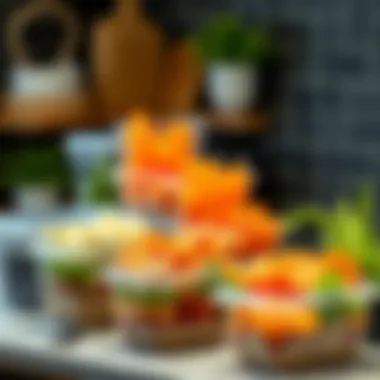
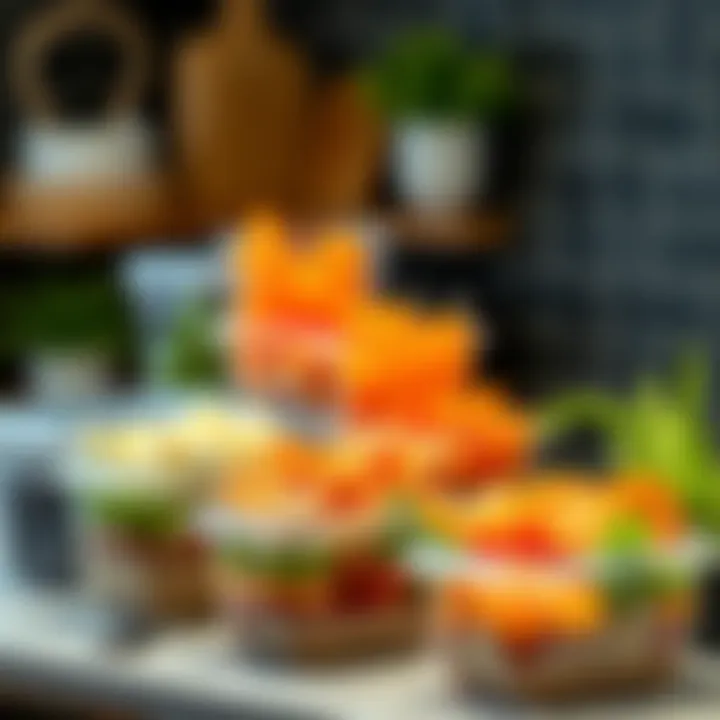
By using containers that feature dividers, you minimize the risk of different food types mixing together. For example, if you have a container with sections for fruits, nuts, and yogurt, the possibility of bacteria from raw items coatings your snack becomes significantly lower. Research has demonstrated that using properly designed containers can decrease the chances of foodborne pathogens thriving in your meals.
"An ounce of prevention is worth a pound of cure." Proper container management is vital in preserving health through safe food practices.
Furthermore, cleaning these containers is straightforward compared to traditional cupboards filled with mismatched plates and bowls. With a quick rinse, you can ensure that each compartment is ready for another round of meal prepping, significantly cutting down on the chance of harboring harmful microorganisms.
Strategies to Reduce Cross-Contamination:
- Designate specific containers for raw meat
- Wash hands and utensils thoroughly between uses
- Store cooked meals separately from raw ingredients
- Consider using color-coded containers to identify food categories
Current Market Trends
In recent years, the market for plastic food containers with dividers has seen noticeable shifts that reflect deeper consumer values and expectations. Understanding these trends can provide insights not just for manufacturers, but also for end users—homeowners, kitchen design enthusiasts, and even retailers. The increasing emphasis on health, convenience, and sustainability has created a distinct landscape in which these containers thrive.
Consumer Preferences
Consumer behavior is constantly evolving, and today's buyers are more discerning than ever. A significant portion of consumers now prioritize functionality and versatility in their kitchen tools. Here are some key preferences:
- Multipurpose Utility: Many consumers are looking for products that serve several functions at once. Plastic food containers with dividers are being favored because they are not just for storage; they also help in meal prepping, portion control, and keeping different food items separate, thereby enhancing meal variety.
- Aesthetic Qualities: The look of kitchen items has become paramount for many buyers. The containers with sleek designs and vibrant colors allow homeowners to display their organization skills without compromising style. Having dividers caters to this aesthetic by keeping various food items neatly arranged and easily visible.
- Safety and Quality: Nowadays, consumers are also focused on health impact—so they are seeking brands that use food-safe materials. Awareness around potential contaminants has heightened scrutiny on the plastic types used in food storage. Brands that communicate transparency regarding their materials often build stronger trust and loyalty with customers.
The buzzing online discussions on platforms like Reddit have shown that people are eager to share their experiences and preferences, which might influence others in their purchasing decisions. Popular opinions often highlight that customers are interested in how these containers simplify their lives, whether for busy weekdays or providing kids with appealing lunches.
Sustainable Options Gaining Popularity
As environmental concerns loom large, sustainability has emerged as a leading factor in consumer choices. Here are some patterns we observe:
- Rise of Eco-Friendly Materials: There's a growing demand for containers that are made from either recycled plastics or biodegradable alternatives. This kind of conscious consumerism reflects a desire to reduce plastic waste and embrace more eco-friendly practices. Brands acknowledging this trend demonstrate their commitment to sustainability, which resonates with a large segment of the market.
- Educated Choices: Consumers are becoming more educated about what materials are compostable or recyclable. They are scrutinizing packaging details, often leading to an inclination towards products labeled with eco-certifications. Brands that offer clear, informative packaging about their environmental benefits frequently gain a competitive edge.
- Long-Lasting Products: People are also leaning toward durable options that can withstand the rigors of daily use while still being eco-conscious. The investment in something that lasts is looked upon favorably, giving consumers less reason to replace them frequently and therefore less impact on landfill overflow.
In a specifically crowded market, the brands that focus not just on immediate functionality but also on their environmental footprint are carving themselves a niche. This overarching trend underlines an important shift in consumer awareness and behavior, shaping how manufacturers approach their product development overall.
Common Misconceptions
Misunderstandings about plastic food containers can spread like wildfire, leading to unwarranted hesitations in their usage. In this section, we demystify some of the most prevalent misconceptions, revealing the practical realities behind the plastic façade. Having clarity on these issues can support homeowners, designers, and DIY enthusiasts alike in making informed choices about their kitchenware.
Durability of Plastic Containers
One of the biggest myths is that plastic containers are inherently flimsy and short-lived. It’s easy to see how people might jump to that conclusion; after all, nobody wants to invest in items that won’t stand the test of time. However, the durability of plastic food containers varies drastically based on the material used and their intended purpose. For example, containers made from polypropylene are known for their resilience and ability to withstand considerable temperature variations, making them ideal for both hot and cold foods.
In contrast, certain cheap containers can warp, scratch, or degrade over time, especially if subjected to extreme heat or prolonged exposure to sunlight. Investing in higher-quality containers equipped with dividers can make all the difference. They maintain structural integrity under pressure, resisting dents and maintaining their shape longer than their lesser counterparts.
To ensure you're choosing the right plastic container for longevity, look for products that offer a warranty. This is often a good indicator of the manufacturer’s confidence in their durability.
Toxicity Myths Regarding Plastics
Another common concern relates to the toxicity of plastic—many folks mistakenly believe that all plastic containers leach harmful chemicals, particularly when heated. The reality is, not all plastics are created equal. Most modern containers are crafted from food-safe materials that adhere to strict regulatory standards. For instance, polyethylene and polypropylene are generally considered safe for food storage. Additionally, many manufacturers have actively phased out BPA, a controversial chemical once prevalent in certain plastics.
Yet, it’s crucial to stay vigilant. Some older containers, or lower-grade products, may still pose risks. Always check the label to make sure your plastic food container is marked as BPA-free and designed for food use. Such diligence helps ensure safe storage for your meals.
In summary, debunking these misconceptions sheds light on the practical advantages of plastic food containers with dividers. Understanding durability and safety can empower consumers to utilize these versatile kitchen tools with confidence.
"Knowledge is power—in the kitchen as in life."
For more insights on kitchen safety and sustainability, consider visiting resources like FDA.gov or National Institutes of Health. This not only enhances food freshness but also supports well-rounded health practices in daily life.
Culmination
In wrapping up our exploration of plastic food containers with dividers, it’s clear that these kitchen essentials play a pivotal role in modern food storage and organization. The versatility they offer transcends mere functionality; they also contribute positively to healthier eating habits and sustainable practices. When we consider the myriad benefits that come with using these containers, it’s hard to overlook their significance in everyday life.
Summarizing Key Points
To summarize, several key points emerge from our discussion:
- Optimized Organization: The dividers within these containers allow for a tidy separation of different food items, making it easier to locate what you need quickly. Whether it’s a dinner prep or a packed lunch, the organized design can’t be beaten.
- Food Integrity Maintenance: Keeping food fresh and uncontaminated is crucial. The use of dividers helps in achieving this by preventing different flavors from morphing into one another, a common issue when food items start to mingle in traditional containers.
- Health Consciences Solutions: By promoting portion control, these containers encourage balanced eating. In an age where health is paramount, having visually separate sections can aid individuals in managing their intake effectively.
- Sustainable Material Options: Many manufacturers are transitioning towards eco-friendly materials, which helps in reducing plastic waste and encourages a healthier planet. As consumers become more aware, they are beginning to seek out options that align with their values.
Most importantly, the trends in the market are evolving, suggesting that consumers are increasingly prioritizing products that not only serve practical functions but also contribute to a greater good. With the significant rise in awareness regarding sustainability, the appetite for sustainable food storage solutions, particularly those with added functionality like dividers, is growing.
Future of Food Storage Solutions
Looking ahead, the future of food storage solutions seems promising. Innovations and trends in design and material science are laying the groundwork for even more advanced containers. Potential developments we might see include:
- Smart Containers: As technology integrates more into our lives, the idea of smart containers that track food freshness or integrate with health apps could transform meal prep as we know it.
- Material Advancements: The evolution of materials, creating lighter yet more durable options, could enhance portability without sacrificing the integrity of the food stored within.
- Customized Containers: The possibility for personalization, allowing users to choose their compartment sizes and designs based on their unique preferences and specific dietary needs, stands to cater to varying consumers' requirements.















